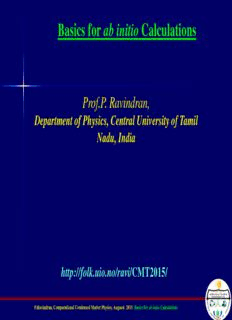Table Of ContentBasics for ab initio Calculations
Prof.P. Ravindran,
Department of Physics, Central University of Tamil
Nadu, India
http://folk.uio.no/ravi/CMT2015/
P.Ravindran, Computational Condensed Matter Physics, Auguest 2015 Basics for abinitioCalculations
Approximation #1: Separate the electrons into 2 types:
Core Electrons & Valence Electrons
The Core Electrons: Those in the filled, inner shells of the
atoms. They play NO role in determining the electronic properties
of the solid.
Example: The Si free atom electronic configuration:
1s22s22p63s23p2
Core Shell Electrons = 1s22s22p6 (filled shells)
These are localized around the nuclei & play NO role in the
bonding.
Lump the core shells together with the Nuclei Ions
(in ∑i , include only the valence electrons)
Core Shells + Nucleus Ion Core
He-n He-i , Hn Hi
P.Ravindran, Computational Condensed Matter Physics, Auguest 2015 Basics for abinitioCalculations
The Valence Electrons
Those in the unfilled, outer shells of the free atoms. These
determine the electronic properties of the solid and take part in
the bonding.
Example:
The Si free atomelectron configuration:
1s22s22p63s23p2
The Valence Electrons = 3s23p2 (unfilled shell)
In the solid, these hybridize with the electrons on neighbor
atoms. This forms strong covalent bonds with the 4 Si nearest-
neighbors in the Si lattice
P.Ravindran, Computational Condensed Matter Physics, Auguest 2015 Basics for abinitioCalculations
Methods for Efficient Computation
K-points (k)
– Discrete points specified in Brillouin Zone used to
perform numerical integration during calculation.
Energy Cut-off Value (ecut)
– Energy value for maximum energy state included in a
summation over electron states.
Pseudopotentials (pp)
– Offers specific exchange-correlation functional form
which represents frozen “core electrons.” They are
based largely on empirical data.
P.Ravindran, Computational Condensed Matter Physics, Auguest 2015 Basics for abinitioCalculations
LDA vs. GGA Approximations
“Local-density approximations (LDA) are a class of
approximations to the exchange-correlation (XC) energy
functional in DFT that depend solely upon the value of the
electronic density at each point in space (and not, for example,
derivatives of the density or the Kohn-Sham orbitals).” This is
more of a first-order approximation.
“Generalized gradient approximations (GGA) are still local but
also take into account the gradient of the density at the same
coordinate.”
P.Ravindran, Computational Condensed Matter Physics, Auguest 2015 Basics for abinitioCalculations
Ensuring k and Ecut Lead to a Converged Energy
The most important skill in performing DFT calculations is the
ability to get converged energies. Since the appropriate choice of
k-points and Ecut vary wildly among different geometries (and
even different required accuracies), it is important to be able to
form the following graphs every time you perform ‘scf’
calculations on new geometries.
Converged values of Ecut and k should be reported any time you
publish DFT results, so that someone else may reproduce your
calculation and agree on the same numerical error.
P.Ravindran, Computational Condensed Matter Physics, Auguest 2015 Basics for abinitioCalculations
Energy Cut-off Convergence Plot
Not only should the graph look converged, but the difference in energy between
the last two consecutive points should be smaller or equal to your required accuracy!
P.Ravindran, Computational Condensed Matter Physics, Auguest 2015 Basics for abinitioCalculations
K-point Convergence Plot
Note: In an automatic
distribution of k-points, the value
of k specifies how many discrete
points there are equally-spaced
along each lattice vector to
populate the Brillouin Zone.
As we can see from the
convergence plots, the
presence of smearing does
little to ensure convergence
with fewer k-points.
P.Ravindran, Computational Condensed Matter Physics, Auguest 2015 Basics for abinitioCalculations
K-point Convergence Plot (cont.)
When unit cells do not have equal-length lattice vectors, it
is sometimes computationally rewarding to “geometrically-
optimize” your automatic k-point distribution.
For example, if one had a unit cell that was four times taller
in one direction than its other two directions, one should
specify only a quarter as many k-points along the taller
direction.
– This makes sense, because in reciprocal space, the taller
distance will only be a quarter as long as the other two
distances.
P.Ravindran, Computational Condensed Matter Physics, Auguest 2015 Basics for abinitioCalculations
Comparing the Relaxed Structure to Literature
P.Ravindran, Computational Condensed Matter Physics, Auguest 2015 Basics for abinitioCalculations
Description:P.Ravindran, Computational Condensed Matter Physics, Auguest 2015 Basics for ab initio Calculations. Basics for ab initio Calculations.

